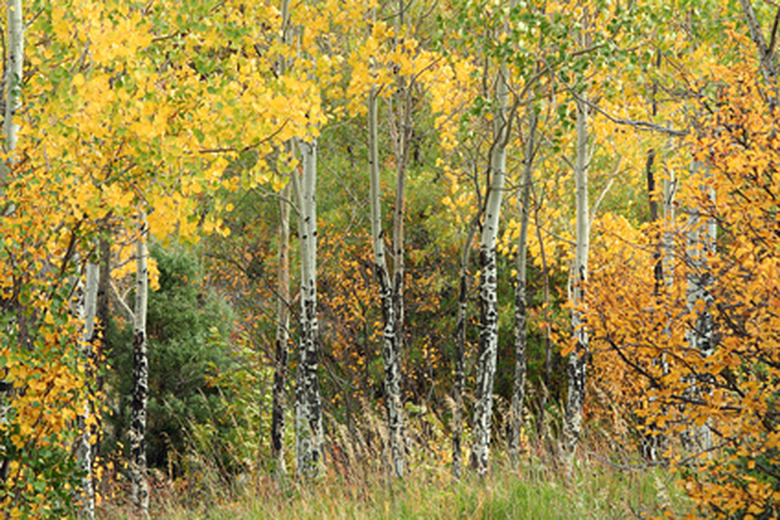Utah Tree Leaf Identification
A wide variety of trees grow in Utah, reflecting the varying terrain. Identify them by examining the color, shape and texture of their leaves, as well as the bark and any flowers or fruits. Native trees, in general, are a good choice for landscaping because they are usually drought tolerant and disease resistant. Aspens, though, rarely flourish in urban landscapes. They prefer the soils and climate of higher altitudes and are generally short-lived when planted in yards.
Variety
In Utah, evergreen varieties include pines, spruces, Douglas-fir, true firs and junipers. Large deciduous trees include maples, aspens, poplars, willows, ashes and oaks. Many small tree varieties grow here as well, such as chokecherry, serviceberry, Russian olive, honey mesquite and Joshua tree. Most native trees are drought tolerant, once established, especially those growing in southern Utah.
- A wide variety of trees grow in Utah, reflecting the varying terrain.
- Most native trees are drought tolerant, once established, especially those growing in southern Utah.
Leaf Shape
The leaves of evergreens, such as the limber pine (Pinus flexilis) and the bristlecone pine (Pinus longaeva) are thin, stiff and grow to 5 inches long. Rocky Mountain juniper (Juniperus scopulorum) leaves are scalelike, while the leaves of firs and spruce are thin, stiff and grow to 1 inch long.
Common deciduous trees, such as the Rocky Mountain maple (Acer glabrum) and the Gambel oak (Quercus gambelii) have deeply cut leaves. Gambel oak is a rambling shrub that reaches 20 feet high, but its leaves, though smaller than tall oak tree varieties, has a typical oak leaf shape.
Leaf Color
Evergreen leaves are typically dark green to sage green. Bristlecone pines' are often covered with white specks of resin, according to the Utah State University Forestry Extension. The quaking aspen (Populus tremuloides) and the Fremont cottonwood (Populus fremontii) have light to dark green leaves that turn brilliant yellow or orange in autumn. Fall colors are more pronounced in the high country. Maples also produce brilliant fall foliage. The evergreen, spear-like leaves of the Joshua tree (Yucca brevifolia) are blue-green. Russian olive (Elaeagnus angustifolia) leaves are silvery, sage green.
- The leaves of evergreens, such as the limber pine (Pinus flexilis) and the bristlecone pine (Pinus longaeva) are thin, stiff and grow to 5 inches long.
- The quaking aspen (Populus tremuloides) and the Fremont cottonwood (Populus fremontii) have light to dark green leaves that turn brilliant yellow or orange in autumn.
Unusual Attributes
The leaves of the velvet or Modesto ash (Fraxinus velutina) are densely hairy, hence the name "velvet" ash. The shiny leaves of the Western hoptree (Ptelea angustifolia) produce a strong odor when crushed. Honey mesquite are identified by their slim leaves and thorns. Common chokecherry (Prunus virginiana) produces tart berries used for jams and syrups.
Regions
Singleleaf dwarf ash (Fraxinus anomala), honey mesquite and the Joshua tree are found only in southern Utah. Common chokecherry, narrowleaf cottonwood (Populus angustifolia) are found throughout Utah. Aspen, serviceberry and evergreen pines and firs are generally found at higher elevations.
- The leaves of the velvet or Modesto ash (Fraxinus velutina) are densely hairy, hence the name "velvet" ash.
- Singleleaf dwarf ash (Fraxinus anomala), honey mesquite and the Joshua tree are found only in southern Utah.
